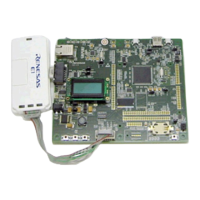R01UH0823EJ0100 Rev.1.00 Page 55 of 1823
Jul 31, 2019
RX23W Group 1. Overview
Communication
functions
Serial Sound Interface (SSI)
1 channel
Capable of duplex communications
Various serial audio formats supported
Master/slave function supported
Programmable word clock or bit clock generation function
8/16/18/20/22/24/32-bit data formats supported
On-chip 8-stage FIFO for transmission/reception
Supports WS continue mode in which the SSIWS signal is not stopped.
SD Host Interface (SDHIa)
1 channel
Transfer speed: Default speed mode (8MB/s)
SD memory card interface (1 bit / 4bits SD bus)
MMC, eMMC Backward-compatible are supported.
SD Specifications
Part 1: Compliant with Physical Layer Specification Ver.3.01 (Not support DDR)
Part E1: SDIO Specification Ver. 3.00
Error check function: CRC7 (command), CRC16 (data)
Interrupt Source: Card access interrupt, SDIO access interrupt, Card detection interrupt,
SD buffer
access interrupt
DMA transfer sources: SD_BUF write, SD_BUF read
Card detection, Write protection
Bluetooth low energy (BLE)
On-chip RF transceiver and link layer compliant with the Bluetooth 5.0 Low Energy specification
Bit rates: 1 Mbps, 2 Mbps, 500 kbps, and 125 kbps
LE Advertising extension support
Includes an RF transceiver power supply (selectable as a DC-to-DC converter or linear regulator)
On-chip matching circuit to help reduce the number of external parts
Transmission power: +4 dBm support
Encryption functions
Access management circuit
Encryption engine
128- or 256-bit key sizes of AES
Block cipher mode of operation: GCM, ECB, CBC, CMAC, XTS, CTR, GCTR
Hash function
True random number generator
Prevention from illicit copying of a key
12-bit A/D converter (S12ADE)
12 bits (14 channels × 1 unit)
12-bit resolution
Minimum conversion time: 0.83 µs per channel when the ADCLK is operating at 54 MHz
Operating modes
Scan mode (single scan mode, continuous scan mode, and group scan mode)
Group A priority control (only for group scan mode)
Sampling variable
Sampling time can be set up for each channel.
Self-diagnostic function
Double trigger mode (A/D conversion data duplicated)
Detection of analog input disconnection
A/D conversion start conditions
A software trigger, a trigger from a timer (MTU, TPU), an external trigger signal, or ELC
Event linking by the ELC
Temperature sensor (TEMPSA)
1 channel
The voltage output from the temperature sensor is converted into a digital value by the 12-bit A/D
converter.
12-bit D/A converter (R12DAA)
2 channels
12-bit resolution
Output voltage: 0.4 to AVCC0-0.5V
CRC calculator (CRC)
CRC code generation for arbitrary amounts of data in 8-bit units
Select any of three generating polynomials:
X
8
+ X
2
+ X + 1, X
16
+ X
15
+ X
2
+ 1, or X
16
+ X
12
+ X
5
+ 1
Generation of CRC codes for use with LSB-first or MSB-first communications is selectable.
Comparator B (CMPBa)
2 channels × 1 unit
Function to compare the reference voltage and the analog input voltage
Window comparator operation or standard comparator operation is selectable
Capacitive touch sensing unit (CTSU) Detection pin: 12 channels
Data operation circuit (DOC) Comparison, addition, and subtraction of 16-bit data
Power supply voltages/Operating frequencies VCC = 1.8 to 2.4 V: 8 MHz, VCC = 2.4 to 2.7 V: 16 MHz, VCC = 2.7 to 3.6 V: 54 MHz
Operating temperature range D version: 40 to +85°C
Packages 85-pin BGA (PTBG0085KB-A) 5.5 × 5.5 mm, 0.5 mm pitch
56-pin QFN (PVQN0056LA-A) 7 × 7 mm, 0.4 mm pitch
Debugging interfaces FINE interface
Table 1.1 Outline of Specifications (4/4)
Classification Module/Function Description

